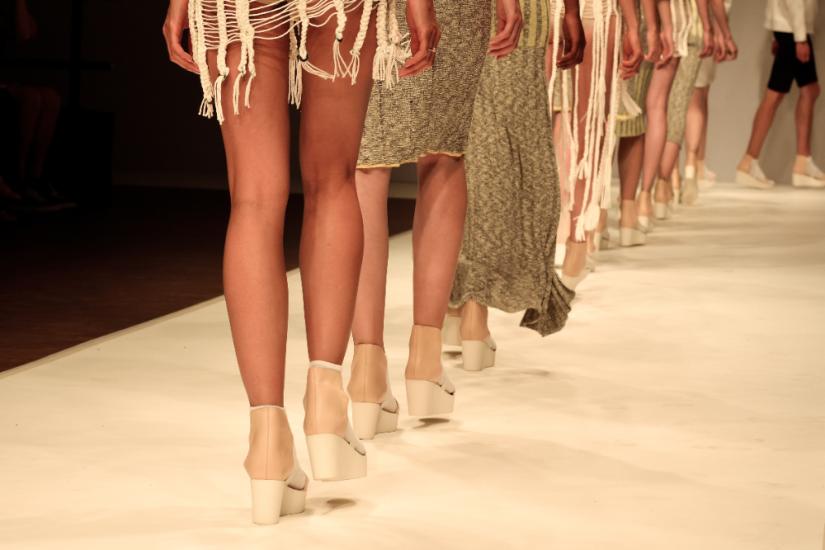‘The first designers and models of this world’: attending the 2023 National Indigenous Fashion Awards.

Models on a catwalk. Image: Adobe Stock
The Darwin winter sunset encircled the city with a brilliant gold. As the crowd anticipated the start of the annual Indigenous fashion parades, the room turned dark, and a lone figure appeared.
As the first model walked, the crowd cheered, excited to see the show they had waited a year to attend.
Throughout two shows, Our Legacy and Our Heart, First Nations models of diverse ages and sizes almost outshone the striking garments they wore.
Designs from 22 labels and collaborations represented the heart and soul of the designers, artists and makers, many who journeyed very long distances for the opportunity to tell their stories through fashion design and art.
The Darwin Aboriginal Art Fair has concluded for another year with more than 70 exhibitors and a successful fashion program. The Indigenous Fashion Projects festival grows in size and quality every year, showing the potential for First Nations fashion – like art and music – to become defining features of Australian life.
Yet beyond the lights, makeup and action, people in the First Nations fashion industry just want their voices to be heard. They see their contributions to fashion, textile design and modelling as contributing to cultural tradition, economics and cultural sustainability, and blak pride and storytelling.
Cultural tradition
The day after the parades, the annual National Indigenous Fashion Awards were held in the beautiful open air. This also provided a moving ceremony as we celebrated the work of 66 First Nations artists, designers and collaborators.
Nearly all the winners referred to the ongoing and living cultural traditions that inform their work, generally framed as female and working with and learning from Elders.
“All those old ladies have passed away but they’re still holding us up,” said a representative from Ikuntji Artists. “Their spirit is still strong and walks with us. Thanks for loving our designs and stories because we know they’re still here with us.”
Fashion designer of the year, Wiradjuri, Gangulu and Yorta Yorta woman Lillardia Briggs-Houston, told the audience: “I am what I am because of my grandmother and grandfather.”
Through both textile and art making, First Nations fashion designers are continuing the unbroken chain of practice that has existed since time immemorial. This was seen on textile designs referencing animals to the construction of exquisite headpieces and jewellery using shells and stones.
Economics and cultural sustainability
Many winners spoke about the economic opportunities afforded by the fashion industry. Selling fashion and textiles supports “money business”, permitting the makers and designers to remain on Country and continue practising culture while taking their work to audiences around Australia.
Economic opportunities are underpinned by cultural sustainability. Gapuwiyak Culture and Arts with Aly de Groot won both the traditional adornment and community collaboration awards for their work in recreating fibre work from an anthropological photograph. They noted how the 19th century women and their work even looked like models lined up on a catwalk.
The need for fashion design and creative training opportunities on Country was emphasised by Briggs-Houston. As she noted, fashion work – pattern cutting, design adjustments, sewing and embellishment – was traditionally women’s work, conducted at home, but no one felt they were a designer, let alone a brand ambassador.
Briggs-Houston studied fashion at TAFE and learnt from her knowledgeable grandmother:
We were always the seamstress but never the designer back then. Now I dedicate my life to cultural sustainability through fashion.
One challenge facing emerging First Nations designers is access. The best fashion schools are concentrated in expensive metropolitan centres. Some students must drive all day to reach TAFE.
Fashion is a complex business. It combines designing, making, marketing, branding, photography, styling, and formats from conventional parades to newer fashion films. How to even touch on these skills and make them accessible?
Several First Nations fashion organisations, such as Indigenous Fashion Projects, First Nations Fashion + Design and Mob in Fashion are helping via in-person, online and mentoring experiences.
Blak pride and storytelling
The Indigenous Fashion Projects festival of events was filled with an assertion of pride and storytelling, as well as a re-configuring of the that idea that fashion is Western and European.
As Northern Territory Arts Minister Chansey Paech (Arrernte/Gurindji) said at the awards, when you buy First Nations fashion “you are buying someone’s story, someone’s connection, someone’s truth”.
The parade and the awards ceremony are always tinged with the modesty of many of the participants. Many live in remote communities and are unused to the spotlight.
As their achievements were listed and screened through beautiful short films about their Country and making (made for NITV broadcast), the audience applause saw them swell with shared confidence. Hayley Dodd from Ikuntji Artists declared when accepting the business achievement award, “We are black. And we are deadly.”
With Australia soon to be deciding on the Voice to Parliament, it is timely to reflect on how much has been achieved with so little financial resources or mainstream power. What might we achieve as a nation if all our peoples are supported, financed and also recognised?
As Paech concluded and reminded us: “First Nations fashion excellence began small. It’s about creativity, excellence and pride. [We are] the first designers and models of this world.”![]()
Peter McNeil, Distinguished Professor of Design History, UTS, University of Technology Sydney and Treena Clark, Chancellor’s Postdoctoral Indigenous Research Fellow, Faculty of Design, Architecture and Building, University of Technology Sydney
This article is republished from The Conversation under a Creative Commons license. Read the original article.

